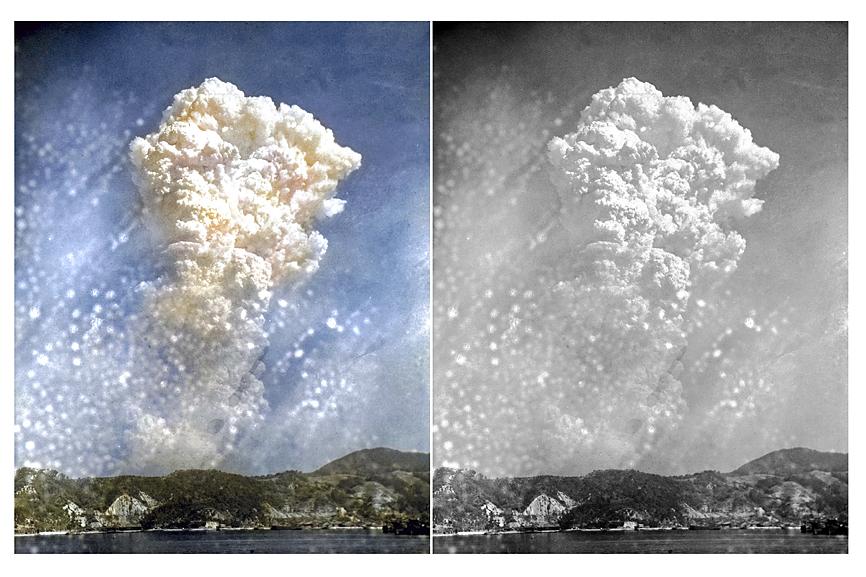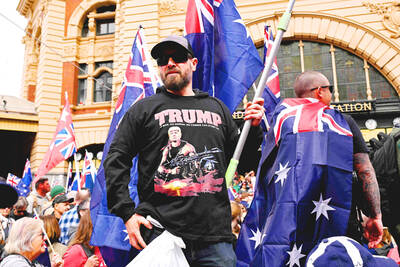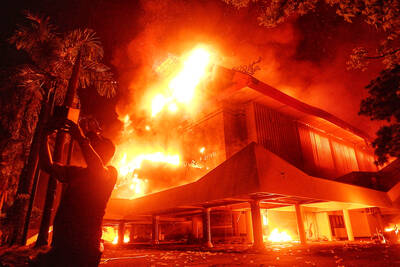When Tokuso Hamai saw a colorized version of a black-and-white photo of a picnic under blossoming cherry trees before World War II, memories of family members, most of whom died in the atomic bombing of Hiroshima in 1945, came pouring out.
“In colorized photos, people come to life,” said Hamai, now 86. “I often played near [the picnic site] and sometimes I would do some naughty things and get scolded by my father.”
The power of a colorized photo to reignite lost memories was eye-opening for Anju Niwata, a student who gave Hamai the colorized photo as a present three years ago.

Photo: AP
The 75th anniversary of the end of World War II is today, and Niwata, now 18, said she hopes it would bring attention to her project with a Tokyo University professor to painstakingly colorize photos using artificial intelligence and their own research to spark lost memories for the rapidly aging generation who experienced the war.
“Seeing Niwata share the colorized pictures with Hamai, and then watching him recall his old memories one after another, made it feel like the ice around his frozen memories was melting away,” said Hidenori Watanave, the professor who taught Niwata how to colorize monochrome pictures using AI.
Niwata and Watanave call their colorization project “Rebooting Memories,” and they published a book last month of the colorized versions of about 350 monochrome photographs that were taken before, during and after the war.
Watanave and Niwata use three different types of AI photo coloring software. The AI is useful in identifying the accurate colors of natural things, such as the sea, the sky and human skin, but it cannot accurately colorize human-made objects like roofs and clothes, Watanave said.
So Niwata and Watanave painstakingly finish the AI-colorized photos by hand to get more accurate colors based on the photo owners’ memories and advice from experts.
They also look through historical documents and archives that show what the colors should look like.
Some photos take a few months to finish.
For Watanave, Twitter has become a powerful platform to pursue the colorization project.
When he posted a picture of the Hiroshima atomic bomb mushroom cloud that the AI software had colorized as white, a film director suggested that it should be more orange.
Watanave checked the testimonies of those who saw the mushroom cloud and also researched the components of the atomic bomb to see if it could actually make an orangish color. After confirming that it could, he added orange to the picture.
While the accuracy of the color is important, Niwata and Watanave said that the most vital thing is that the colorized photos match the memories of their owners.
However, time is running out: The average age of the atomic bomb survivors is about 83.
Niwata said that publishing the colorization book during the COVID-19 pandemic has made her think about analogies to the war.
“Our everyday lives have been stolen away by the coronavirus in a flash, which I think resembles what happened in the war. That’s why I feel like now is an opportunity for people to imagine [wartime life] as their own experience,” she said.
Watanave said that using new technology would hopefully help younger Japanese feel more of an attachment to those who lived through the war.
“People are forgetting wartime memories. We need to revitalize those old memories by using the latest method of expression and delivering it to the hearts of many people,” he said. “By the time we mark the 80th or 85th anniversary, we need to come up with a new way of expressing” wartime memories.

Australia has announced an agreement with the tiny Pacific nation Nauru enabling it to send hundreds of immigrants to the barren island. The deal affects more than 220 immigrants in Australia, including some convicted of serious crimes. Australian Minister of Home Affairs Tony Burke signed the memorandum of understanding on a visit to Nauru, the government said in a statement on Friday. “It contains undertakings for the proper treatment and long-term residence of people who have no legal right to stay in Australia, to be received in Nauru,” it said. “Australia will provide funding to underpin this arrangement and support Nauru’s long-term economic

‘NEO-NAZIS’: A minister described the rally as ‘spreading hate’ and ‘dividing our communities,’ adding that it had been organized and promoted by far-right groups Thousands of Australians joined anti-immigration rallies across the country yesterday that the center-left government condemned, saying they sought to spread hate and were linked to neo-Nazis. “March for Australia” rallies against immigration were held in Sydney, and other state capitals and regional centers, according to the group’s Web site. “Mass migration has torn at the bonds that held our communities together,” the Web site said. The group posted on X on Saturday that the rallies aimed to do “what the mainstream politicians never have the courage to do: demand an end to mass immigration.” The group also said it was concerned about culture,

ANGER: Unrest worsened after a taxi driver was killed by a police vehicle on Thursday, as protesters set alight government buildings across the nation Protests worsened overnight across major cities of Indonesia, far beyond the capital, Jakarta, as demonstrators defied Indonesian President Prabowo Subianto’s call for calm. The most serious unrest was seen in the eastern city of Makassar, while protests also unfolded in Bandung, Surabaya, Solo and Yogyakarta. By yesterday morning, crowds had dispersed in Jakarta. Troops patrolled the streets with tactical vehicles and helped civilians clear trash, although smoke was still rising in various protest sites. Three people died and five were injured in Makassar when protesters set fire to the regional parliament building during a plenary session on Friday evening, according to

CRACKDOWN: The Indonesian president vowed to clamp down on ‘treason and terrorism,’ while acceding to some protest demands to revoke lawmaker benefits Protests in Indonesia over rising living costs and inequality intensified overnight, prompting Indonesian President Prabowo Subianto to cancel a planned trip to China, while demonstrators reportedly targeted the homes of the finance minister and several lawmakers. Rioters entered Indonesian Minister of Finance Sri Mulyani Indrawati’s residence near Jakarta early yesterday, but were repelled by armed forces personnel, Kompas reported. Items were taken from the homes of lawmaker Ahmad Sahroni and two others, according to Detik.com. The reports of looting could not be independently verified, and the finance ministry has not responded to requests for comment. The protests were sparked by outrage over